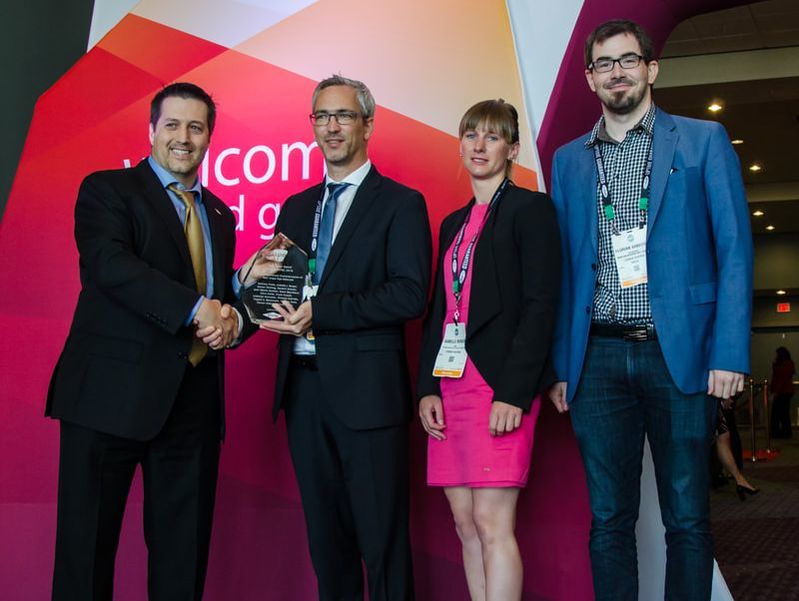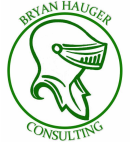If you like reading this blog, be sure to check out our Film Blog, featuring new content from the world of Plastic Films!
Dow Best Paper Award Presentation for the Plastic Pipe and Fittings SIG ANTEC 2018. Pictured from left Dell Doyle of Dow, Andreas Frank, Isabelle J. Berger and Florian Arbeiter.
May 11, 2018
Successful Plastic Pipes and Fittings Special Interest Group Session at ANTEC® 2018
The organizing committee sincerely thanks all the speakers, co-authors and attendees who helped to make this Plastic Pipes & Fittings Special Interest Group (SIG) conference session truly successful. The presentations at ANTEC® 2018 were all outstanding. The Dow Best Paper Award was presented to "Fracture Mechanical Characterization of Non-Virgin Pipe Materials". The paper which focuses on slow crack growth (SCG) testing concludes by stating "The results show, that non-virgin polymers . . . have significantly lower SCG resistance than virgin pipe grades. For some materials the reduced SCG resistance can be attributed to organic or inorganic impurities as well as to other grades than for extrusion". Contributing authors of the best paper were Andreas Frank, Isabelle J. Berger, Günter Dreiling, Norbert Schuler, Jens-Martin Storheil, Erwin Mayrbäurl, Chris Smith, Frank Krause, Lodewijk Niemöller, Philippe Gabriëls, Yogesh S. Deshmukh, Thomas Koch, and Florian Arbeiter with the presentation provided by Mr. Frank. The Dow Best Paper Award recognizes technical merit and innovation for technology advancements in thermoplastic piping systems connecting communities with vital infrastructure. For those who were not able to join us at ANTEC this year, there is still more good news. We hope to arrange for the publication of the award winning paper in Plastics Engineering magazine in the coming months.
For those looking to play a greater role in the Plastics Pipe and Fittings SIG, please contact Bryan Hauger, Technical Program Chair, Plastics Pipe and Fittings SIG at [email protected] or call +1 720.450.0798.
May 13, 2018
Best Practices for Problem Solving Through Plastics Testing By Rich Geoffroy
Quite often when a laboratory is approached with a seemingly straight-forward problem, rather than propose a simple test to provide some relevant information, they outline a research program instead. I don’t know if it’s overzealous salesmanship or simply that they don’t know how to answer the customer’s question (remember, the real customer may be internal rather than external to the laboratory’s organization). Too many times programs are based on the type of equipment available in the lab, or the specific expertise of the individual to whom the question has been posed. They immediately jump into familiar tests, sometimes with seemingly no regard as to the potential value the data will provide to the customer.
Whether you suspect that you might know the answer or not, testing programs should be approached simplistically. Like any other technical problem, the program should be approached in a scientific manner --- 1) form an hypothesis, 2) test the hypothesis, 3) form a decision about the hypothesis , and 4) either modify the hypothesis and repeat steps 1 through 3, or form a conclusion. Problems should be addressed with an initial “quick-and-dirty” approach. Make a quick, yet thoughtful, assumption as to the problem. Perform one or two simple, inexpensive tests that could confirm or eliminate the hypothesis. Usually simple inexpensive tests don’t provide all the information you need to answer the customer’s question, but they can provide direction which can eliminate unnecessary, more expensive testing.
If the test doesn’t confirm your hunch, now is a good time to rethink the problem, possibly get some fresh ideas from colleagues, and try another approach. If you hit a wall, honestly confront your customer --- don’t continue testing in the hope that some answer will suddenly pop up. If, however, the preliminary data supports the initial hypothesis, additional, more elegant testing may be substantiated --- but check with the customer. All too often the customer doesn’t want the sophisticated answer; he too may only be looking for direction, and that “down-and-dirty” approach may be all that he needs. Another advantage for keeping the customer in the loop is that new information is gained each time you talk. Sometimes it’s because you may have misinterpreted some information given, or more often than not, significant information is not revealed by the customer because he assumes it may not be relevant. Nevertheless, constant communication will help you get the information you need to solve the problem, as well as help you to better understand what level of sophistication your customer needs to satisfy his problem.
Remember, the purpose of a test program it to satisfy the needs of your customer, not to resolve all the scientific issues that may arise.
May 25, 2018
Pipeline Plastics Announces Expansion Plans
Pipeline Plastics LLC has announced it will build a new HDPE pipe extrusion facility on the Southeast coast of the United States although the exact location has not yet been announced. Pipeline also announced that they are adding capacity at their manufacturing plants in Texas and South Dakota. The company also announced plans to build a fourth location by late 2019 but has not disclosed the location. With estimated annual sales of $95 million, Pipeline has shown that it has what it takes to grow the HDPE market in energy production, municipal and industrial markets. More Info
May 11, 2018
Successful Plastic Pipes and Fittings Special Interest Group Session at ANTEC® 2018
The organizing committee sincerely thanks all the speakers, co-authors and attendees who helped to make this Plastic Pipes & Fittings Special Interest Group (SIG) conference session truly successful. The presentations at ANTEC® 2018 were all outstanding. The Dow Best Paper Award was presented to "Fracture Mechanical Characterization of Non-Virgin Pipe Materials". The paper which focuses on slow crack growth (SCG) testing concludes by stating "The results show, that non-virgin polymers . . . have significantly lower SCG resistance than virgin pipe grades. For some materials the reduced SCG resistance can be attributed to organic or inorganic impurities as well as to other grades than for extrusion". Contributing authors of the best paper were Andreas Frank, Isabelle J. Berger, Günter Dreiling, Norbert Schuler, Jens-Martin Storheil, Erwin Mayrbäurl, Chris Smith, Frank Krause, Lodewijk Niemöller, Philippe Gabriëls, Yogesh S. Deshmukh, Thomas Koch, and Florian Arbeiter with the presentation provided by Mr. Frank. The Dow Best Paper Award recognizes technical merit and innovation for technology advancements in thermoplastic piping systems connecting communities with vital infrastructure. For those who were not able to join us at ANTEC this year, there is still more good news. We hope to arrange for the publication of the award winning paper in Plastics Engineering magazine in the coming months.
For those looking to play a greater role in the Plastics Pipe and Fittings SIG, please contact Bryan Hauger, Technical Program Chair, Plastics Pipe and Fittings SIG at [email protected] or call +1 720.450.0798.
May 13, 2018
Best Practices for Problem Solving Through Plastics Testing By Rich Geoffroy
Quite often when a laboratory is approached with a seemingly straight-forward problem, rather than propose a simple test to provide some relevant information, they outline a research program instead. I don’t know if it’s overzealous salesmanship or simply that they don’t know how to answer the customer’s question (remember, the real customer may be internal rather than external to the laboratory’s organization). Too many times programs are based on the type of equipment available in the lab, or the specific expertise of the individual to whom the question has been posed. They immediately jump into familiar tests, sometimes with seemingly no regard as to the potential value the data will provide to the customer.
Whether you suspect that you might know the answer or not, testing programs should be approached simplistically. Like any other technical problem, the program should be approached in a scientific manner --- 1) form an hypothesis, 2) test the hypothesis, 3) form a decision about the hypothesis , and 4) either modify the hypothesis and repeat steps 1 through 3, or form a conclusion. Problems should be addressed with an initial “quick-and-dirty” approach. Make a quick, yet thoughtful, assumption as to the problem. Perform one or two simple, inexpensive tests that could confirm or eliminate the hypothesis. Usually simple inexpensive tests don’t provide all the information you need to answer the customer’s question, but they can provide direction which can eliminate unnecessary, more expensive testing.
If the test doesn’t confirm your hunch, now is a good time to rethink the problem, possibly get some fresh ideas from colleagues, and try another approach. If you hit a wall, honestly confront your customer --- don’t continue testing in the hope that some answer will suddenly pop up. If, however, the preliminary data supports the initial hypothesis, additional, more elegant testing may be substantiated --- but check with the customer. All too often the customer doesn’t want the sophisticated answer; he too may only be looking for direction, and that “down-and-dirty” approach may be all that he needs. Another advantage for keeping the customer in the loop is that new information is gained each time you talk. Sometimes it’s because you may have misinterpreted some information given, or more often than not, significant information is not revealed by the customer because he assumes it may not be relevant. Nevertheless, constant communication will help you get the information you need to solve the problem, as well as help you to better understand what level of sophistication your customer needs to satisfy his problem.
Remember, the purpose of a test program it to satisfy the needs of your customer, not to resolve all the scientific issues that may arise.
May 25, 2018
Pipeline Plastics Announces Expansion Plans
Pipeline Plastics LLC has announced it will build a new HDPE pipe extrusion facility on the Southeast coast of the United States although the exact location has not yet been announced. Pipeline also announced that they are adding capacity at their manufacturing plants in Texas and South Dakota. The company also announced plans to build a fourth location by late 2019 but has not disclosed the location. With estimated annual sales of $95 million, Pipeline has shown that it has what it takes to grow the HDPE market in energy production, municipal and industrial markets. More Info
© Copyright Bryan Hauger Consulting, Inc., 2018. All rights reserved.

